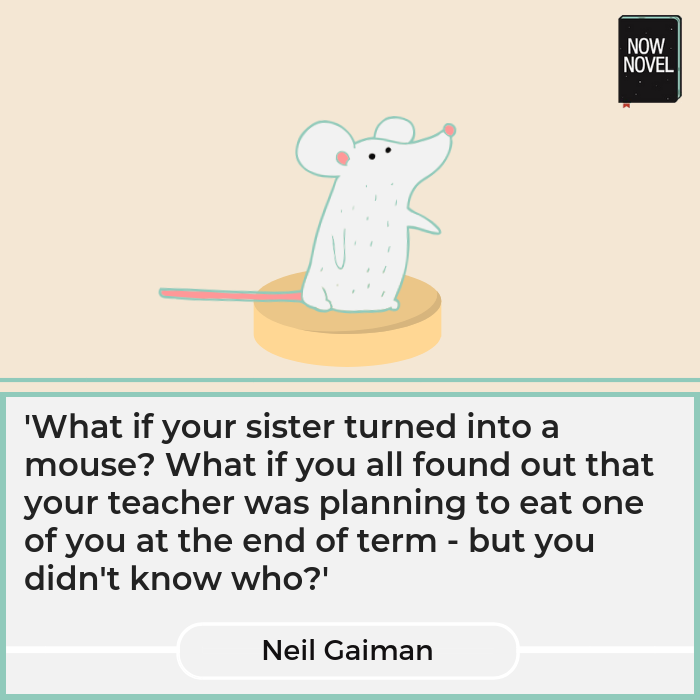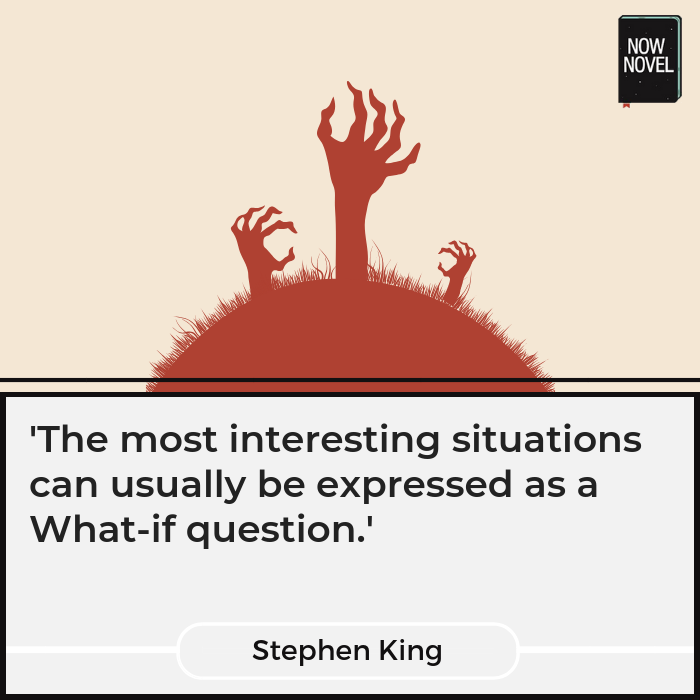Developing stories from the foundations of an idea to full novels is challenging. Yet the simple question 'What if?' is a powerful tool. Read 5 examples of ways you can use this versatile question to imagine story developments:
1. Ask 'What if...?' to find your story scenario's scope
A 'scenario' is a 'postulated sequence or development of events' (Oxford Dictionary). Oxford Dictionaries Online gives this example:
‘a possible scenario is that he was attacked after opening the front door’
Oxford Dictionaries Online, 'Scenario'
Plot development begins with finding characters or scenarios that would make a good story idea. This question could be as simple as:
'[What if...] Someone is attacked after opening his front door[?]'
A scenario such as this gives immediate scope (limits, conditions) for a story. We know it will involve someone being attacked. We know that the event that sets the story in motion (the inciting incident) takes place in a character's home.
The useful thing about 'what if...?' is that it begs an answer. We might continue this scenario by asking any of the following questions:
- Why was the man attacked?
- Who is the attacker?
- What will the man do to defend himself?
- What will the outcome of this surprise attack be?
When we ask 'What if...?' we set conditions, limits, for what could happen next. And these limits reveal creative options and possibilities if we stay curious and keep asking questions.
2. Use 'What if....?' to daydream
There's a reason we called the 'What if...?' step in our story outlining tool 'daydream'. Because the question 'What if...?' takes us into a world of intriguing shadowy states. A world of 'could', 'maybe', and 'perhaps'.
Maybe the door-opening man will escape unscathed. Maybe the attacker is known to him. Or could it be something even more unknown than a stranger, a supernatural (rather than immediately decipherable) force?
These shadowy states of wondering and not knowing can feel hard when working on a story. We've seen this in the fact members using our story outlining dashboard struggle sometimes with this part of finding and developing ideas. We often prefer the comfort of certainties. Answers before questions. A 'right' way to proceed, and a 'wrong' one.
Yet the imaginative world of storytelling demands we grapple with the coulds and maybes and see where they lead.
Neil Gaiman put it well in an essay on his website, 'Where do you get your ideas?' where he writes:
You get ideas from daydreaming. You get ideas from being bored [...] The only difference between writers and other people is we notice when we're doing it.
Neil Gaiman, 'Where do you get your ideas?', neilgaiman.com
You get ideas when you ask yourself simple questions. The most important of the questions is just, What if…?
(What if you woke up with wings? What if your sister turned into a mouse?)

The absurd wildness of Gaiman's last example gives us another important use of 'What if...?':
3. Ask 'What if...?' to play and explore
Developing stories is a matter of allowing yourself the freedom to play, explore, make the 'wrong' step (for your story). And backtrack, too, having learned valuable insights on your characters in the process.
The absurdity of Gaiman's last example shows the delight that often comes with churning out madcap ideas. For example, taking Oxford's attacker-behind-the-door, we could ask:
- What if the attacker were stark naked?
- Or what if the attacker tripped and fell down the front steps?
- Or what if the attacker stopped and said 'Oh! It's you again...'?
Stephen King writes of the benefits of this type of curious play in the writing process. In his book On Writing: A Memoir of the Craft, he compares the act of developing a story (Misery) to a paleontologist patiently brushing away dirt to reveal the earth's ancient mysteries:
'[story developments were] organic, each arising naturally from the initial situation, each an uncovered part of the fossil...'
Stephen King, On Writing: A Memoir of the Craft, p. 169
To King, like Gaiman, developing a story is a process of scraping the dirt away from the compacted fossil of an idea. Because only by tumbling that idea around further can you find its most interesting grooves and contours.

4. Ask 'What if...?' to develop characters
Developing story ideas is a process of finding what endures and what changes. How do characters carry things: Wants, desires, grudges, traumas, hopes? What do they leave behind?
You could sum up the character arc of Dostoevsky's classic, harrowing novel Crime and Punishment (1866) using the following 'What if...?':
'What if a cash-strapped dropout convinced himself it was ethical to murder a stingy pawnbroker he'd borrowed money from and carried out the deed?'
This (like many efforts at summarizing) is a simplification of the killer protagonist Rodion's scenario. Yet it gives us plenty of fodder for developing a story. We could ask further questions to develop:
- Motivations: Why does Rodion drop out of his studies? Why does he believe it isn't a terrible thing to murder?
- Consequences: What if someone else (unbeknownst to him, at first) witnessed the murder? (This is an actual plot point from the story)
- Further developments: What if his conscience troubled Rodion so much that he put himself at risk of being caught?
You can see how by focusing on different aspects of Rodion's story (such as his situation, how he acts on that situation, and the consequences) we can ask 'What if...?' and find ideas for a character arc before we've written a word of a scene.
5. Use 'What if...?' to develop place
Place and time - core elements of a story's setting - are key when developing stories. Where and when events occur determines a lot: Possible outcomes, for example. Blow a vehicle part in outer space and you have bigger problems than having to pull over on the highway!
'What if...?' examples for famous stories
Taking settings for famous stories, we can imagine 'What if...?' questions that would help an author invent them:
- What if there was a train to a magic school you could only get to by running full speed at the wall between platforms 9 and 10 at King's Cross station in London? (J.K. Rowling's Harry Potter series)
- What if there was a wood between worlds, where each pool was a portal to another world, some long since destroyed by conflict and others only just recently born? (C.S. Lewis, The Magician's Boy)
- What if Great Britain became a province of a super-state that completely outlawed free thought? (George Orwell's dystopian classic Nineteen Eighty-Four)
Each of these examples shows a hypothetical question that could lead to inventing a story location so beloved that people queue to take pictures with a wall!
When developing stories, to develop elements of place such as time, change and society, ask questions such as:
- What if everything about this place were to change in one afternoon?
- What if the political system of this place negatively impacted individual freedom immensely? (As in Orwell's version of Great Britain.)
- What if this real, familiar place had a hidden, magical dimension only the initiated knew about? (Rowling's platform)
Complete the free first section of our story outlining tool, 'Central Idea', and use 'What if...?' to start asking questions that unearth fuller stories buried within your ideas.








